
14
Panel Descriptions
Side Panel
fig.03-02
1.Line Output Jacks
These are for connecting equipment such as an external
stereo set or speaker with built-in amplifier.
2.AUX Input Jacks
These are for connecting external equipment, such as a
MIDI sound module, or CD and MD players.
3.Mic Input Jack
This is for connecting an XLR type (unbalanced input)
microphone.
* The pin assignments for the XLR type connectors are as shown below.
Before making any connections, make sure that these pin assignments are
compatible with that of all your other devices.
fig.03-04
* Because pin 3 is connected to ground (GND), when connecting a
balanced-output device, make sure that unbalanced connection is possible.
* When using the A Input jack at the same time, the signal from the A Input
jack takes priority, and the signal from the Mic Input jack is not input.
4.A Input Jack
This is for connecting standard output from a 1/4 inch
phone mike, a TRS-phone (unbalanced input) mike,
synthesizer, or the like.
* The pin assignment of a TRS-phone mike is as shown below. Before
making any connections, make sure that this pin assignment is compatible
with all your other devices.
* Because RING is connected to ground (GND), when connecting a
balanced-output device, make sure that unbalanced connection is possible.
fig.03-05
5.B Input Jack
Connect the guitar after routing it through your multi-
effects processor or similar equipment. It’s also for
connection to synthesizer output.
6.Guitar Input Jack
This is for direct high-impedance connection to a guitar.
* When using the B Input jack at the same time, the signal from the B Input
jack takes priority, and the signal from the Guitar Input jack is not input.
7.Headphones Jack
This is for connecting headphones. Sound is output from the
Line Output jacks even when headphones are connected.
Rear Panel
fig.03-03
1.AC Inlet
This is for connecting the power cord.
2.Power Switch
This switches the power on and off.
3.USB Connector
By connecting this to a computer using a USB cable, you can
exchange audio signals, MIDI signals, and U-8 control signals.
4.MIDI OUT Connector
This is for connecting to the MIDI input on another MIDI
instrument to send MIDI messages.
5.MIDI IN Connector
This is for connecting to the MIDI output on another MIDI
instrument to receive MIDI messages.
6.Foot Switch Jack
This is for connecting a foot switch. When the U-8 Mixer is
activated, you can use this switch to inclement an effect
patch in the Effect Patch Manager. Otherwise, this switch
works as the same as the Record Button.
7.Digital Output Connector
This is for making the connection for digital output to
digital audio equipment such as a DAT or MD device.
8.Digital Input Connector
This is for making the connection for digital input from
equipment such as a CD, MD, or DAT device.
1
2
3
4
5
6
7
1
2
3
1:GND
2:HOT
3:GND
GND (SLEEVE)
HOT (TIP)
COLD (RING)
2
1
3
6
7
8
4
5















































